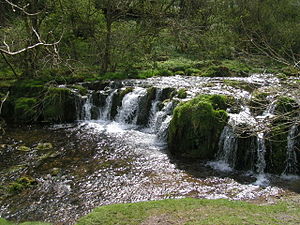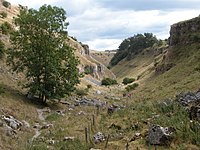River Lathkill

The River Lathkill is a river six and a half miles long in the Peak District in Derbyshire.
The river is first recorded by name in 1280. The name 'Lathkill' possibly has Scandinavian roots, from the Old Norse hlada-kill translating as "narrow valley with a barn".[1]
Course



In times of high rainfall the source of the river is Lathkill Head Cave (SK170658), but in normal conditions the river rises from springs slightly further down the Lathkill Dale valley,[2] close to the village of Monyash, west of Bakewell, and flows generally eastward past the village of Over Haddon and through the village of Alport (where it is joined by the River Bradford) until it meets the River Wye near Rowsley. Roughly six and a half miles from source to outfall, it is the only river in the district that flows over limestone for its entire length.
The mediæval Conksbury Bridge (SK211656) now carries the road from Bakewell to Youlgreave.
History
The dale has a history of lead mining, and among the trees on the north side of the valley are the remains of the 19th-century Mandale Mine, including an old aqueduct and the ruined pump house,[2] used as one of the last attempts to keep the mines drained and workable.
The water in the river is often clear, and Izaak Walton wrote in The Compleat Angler that it is:
| “ | ... by many degrees, the purest and most transparent stream that I ever saw, either at home or abroad, and breeds, it is said, the reddest and best Trouts in England.[3] | ” |
Indeed, when the river is at its clearest the fish can be seen from one bank across to the other.
Among the species that thrive there are brown trout, dipper, and the rare wild plant Jacob's ladder.
Through the use of Bluetooth, it is now possible at particular locations in the nature reserve for visitors to download pictures of flowers and birds, and also examples of birdsong, onto their mobile phones.
On film
The dale was used as a filming location for The Princess Bride.[4][5]
Outside links
References
- ↑ White Peak Walks, The Northern Dales, Mark Richards, 1985 ISBN 0-902363-53-0
- ↑ 2.0 2.1 Derbyshire Dales National Nature Reserve – Natural England
- ↑ Walton, Izaak (16 April 2013). The Compleat Angler. Read Books Limited. ISBN 978-1-4465-4793-9. https://books.google.com/books?id=11J8CgAAQBAJ. Retrieved 18 November 2016.
- ↑ Fox, Caroline (11 October 2020). "Where The Princess Bride Was Filmed: All Locations". Screen Rant. https://screenrant.com/princess-bride-movie-filming-locations/.
- ↑ "The Princess Bride Locations". https://www.latlong.net/location/the-princess-bride-locations-184.